Key takeaways:
- The mobile-first approach prioritizes mobile user experience by focusing on essential content and functionality for smaller screens before expanding to larger devices.
- Responsive design and performance optimization are critical to ensuring users have a seamless experience across different devices.
- User empathy and continuous feedback are vital for understanding user behavior and enhancing engagement during the design process.
- Recognizing the importance of content hierarchy and readability can significantly improve navigation and user satisfaction on mobile platforms.
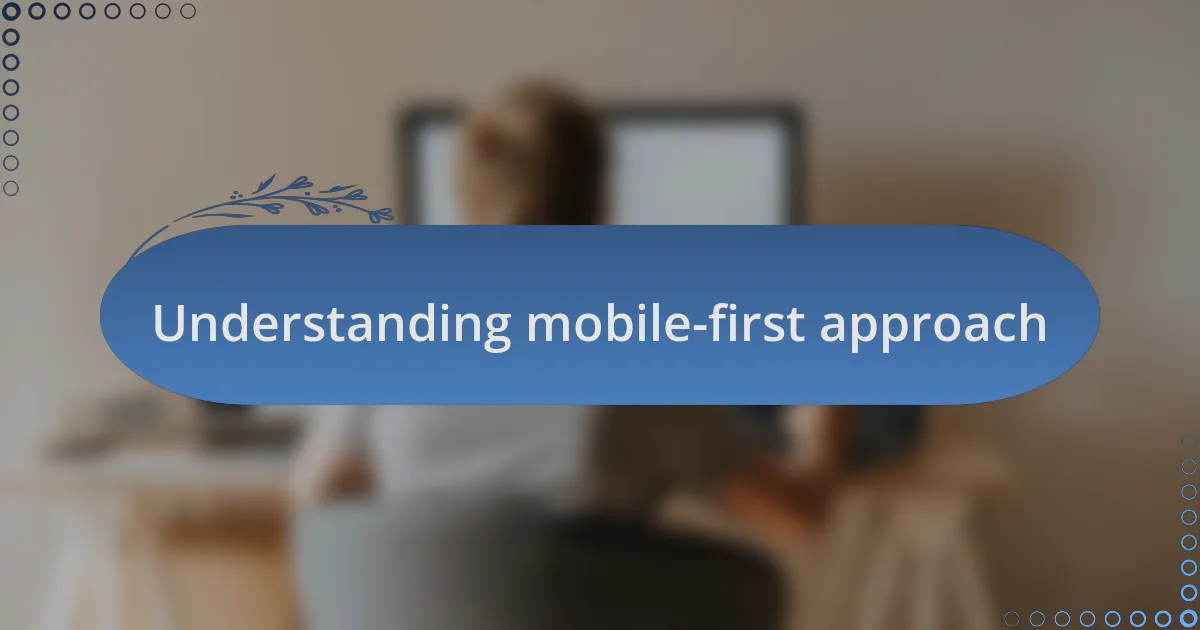
Understanding mobile-first approach
The mobile-first approach fundamentally shifts the way we think about website design. I remember the first time I had to build a site primarily for mobile users; it was eye-opening. It made me realize how limiting traditional designs could be when I focused solely on desktop users.
This perspective centers on optimizing the user experience for mobile devices before expanding it to larger screens. Have you ever tried using a website on your phone that wasn’t designed for it? I’ve felt that frustration of pinching and zooming, and that experience motivated me to prioritize mobile-first design in my own projects.
By starting with mobile, I’ve found that I naturally streamline content and features, ensuring that only the most crucial elements make their way to the smaller screen. It’s like peeling away the unnecessary layers, and I can’t help but feel a sense of satisfaction every time I see users easily navigating my designs on their smartphones. This focus not only enhances usability but also often leads to a cleaner, more effective design overall.

Importance of mobile user experience
When I reflect on the importance of mobile user experience, I can’t help but think about the countless times I’ve abandoned a site because it was frustrating to navigate on my phone. I once clicked on a link while waiting in line, only to be greeted with tiny text and buttons that were impossible to tap. That moment reinforced for me how crucial it is for websites to be intuitive and user-friendly on mobile devices.
Every time I focus on mobile design, I’m reminded of what I consider the “two-second rule.” If a user can’t find what they need within two seconds, they’re likely to move on. I’ve seen firsthand how a well-optimized mobile layout can significantly enhance engagement and reduce bounce rates. Users genuinely appreciate when a website caters to their needs, especially when they’re on the go.
I’ve also noticed that the emotional connection users feel with a website often comes from smooth interactions on their mobile devices. A site that loads quickly and flows seamlessly fosters trust and satisfaction. Can you imagine the impact of a positive mobile experience on a user’s perception of a brand? For me, it’s evident: investing in mobile user experience isn’t just wise; it’s essential for fostering lasting relationships with users.
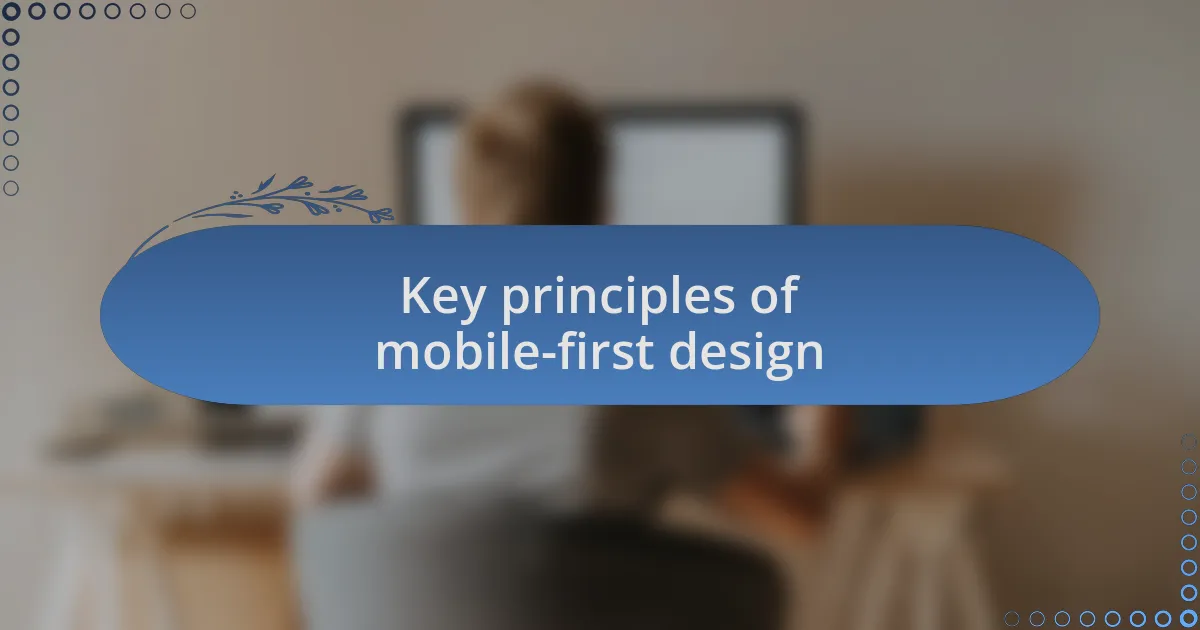
Key principles of mobile-first design
When considering mobile-first design, prioritizing content hierarchy is paramount. I’ve found that starting with the essential elements makes it easier for users to navigate. For instance, during a recent project, I reorganized the layout to ensure that critical information appeared first, leading to a noticeable improvement in user engagement.
Another principle is readability. I can’t stress enough how important it is to use larger fonts and ample spacing for mobile screens. I remember revamping a client’s website where the original text was cramped and difficult to read. After updating it, the feedback was overwhelmingly positive—users felt more comfortable and confident in their ability to consume the content.
Lastly, touch-friendly design is crucial. It boggles my mind how often I encounter websites with tiny buttons that require pinching and zooming. I once struggled to book a reservation on my phone, which deterred me from using the site again. Making buttons larger and spacing them out not only enhances usability but also improves the overall mobile experience. Wouldn’t you agree that a few simple design choices can significantly impact how users interact with a site?
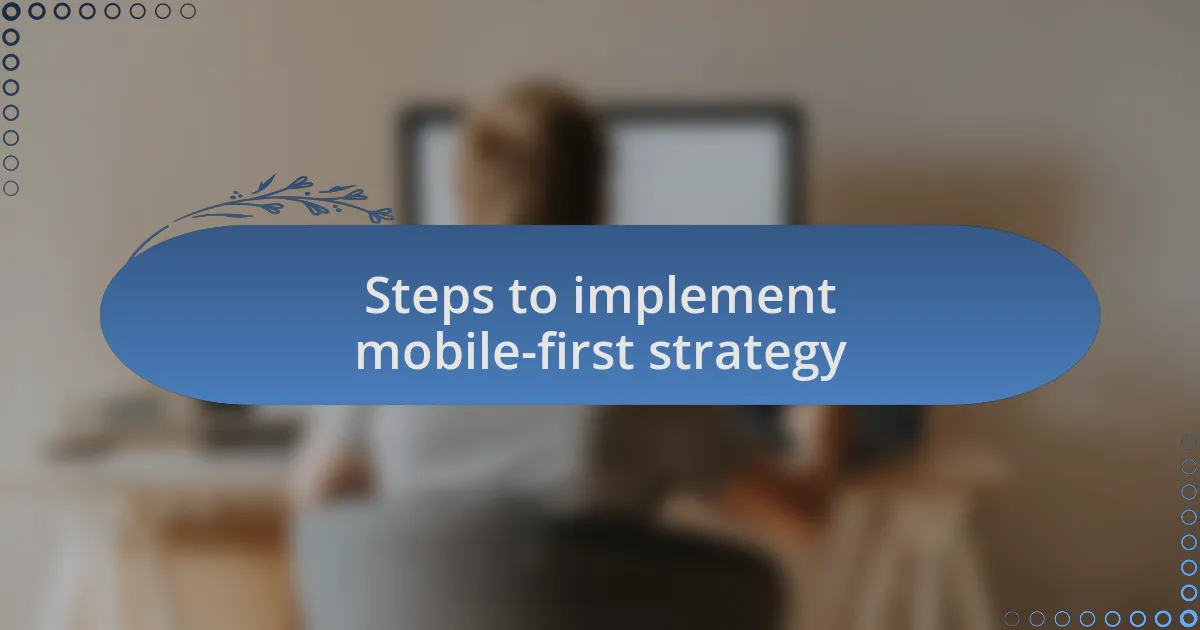
Steps to implement mobile-first strategy
To implement a mobile-first strategy, the first step is to define the core functionalities and content that your users need most when accessing your site on a mobile device. I recall a project where we had to identify the must-haves for a mobile app. We immersed ourselves in user testing, which revealed that people preferred quick access to essential features rather than a plethora of options. This made prioritizing content a lot easier.
Next, you should adopt responsive design practices. I once collaborated on a website redesign where we ensured that every element, from images to text, adapted fluidly across different devices. This experience taught me just how vital it is to test on various screen sizes. The joy on our client’s face when users reported seamless navigation, regardless of device, was priceless.
Finally, remember that performance optimization cannot be overlooked. Throughout my career, slow-loading websites on mobile have been a significant pain point for users—me included! I still remember the frustration of waiting for a page to load; it felt like an eternity. By compressing images and minimizing scripts, I’ve seen firsthand how faster load times lead to reduced bounce rates and happier users. Isn’t it amazing how a few technical tweaks can transform a user’s experience?
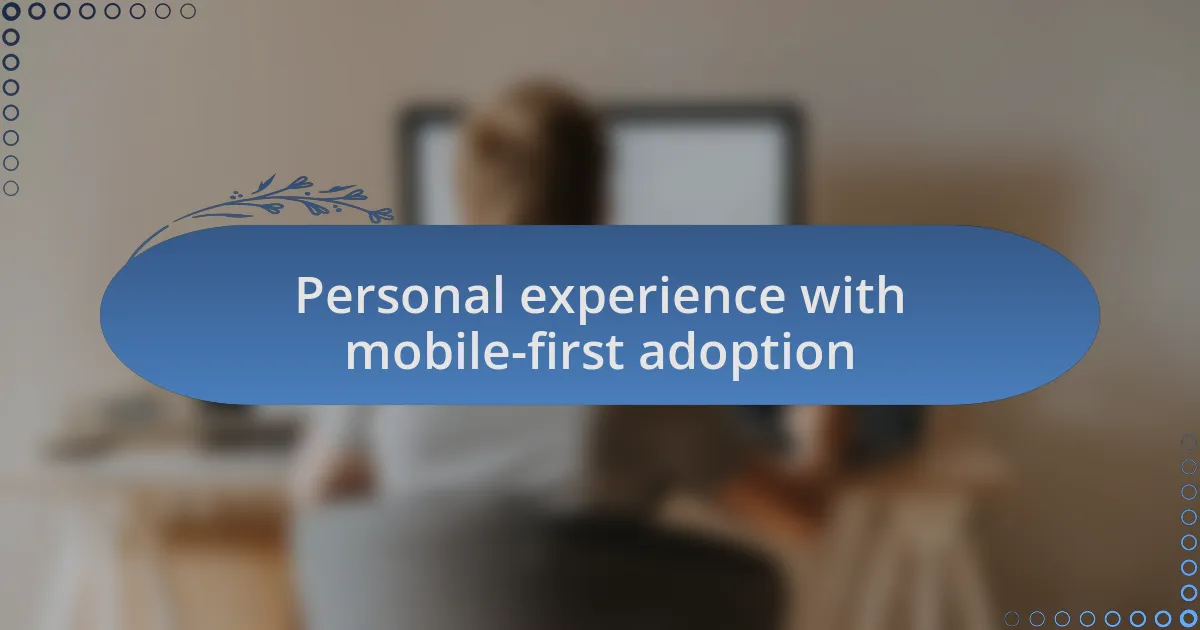
Personal experience with mobile-first adoption
Adopting a mobile-first approach has truly reshaped my perspective on web development. I vividly remember the initial challenges I faced when transitioning from a desktop-centric mindset. At first, I felt overwhelmed by the need to simplify designs without sacrificing functionality, but I discovered something important: less is often more. Who would have thought that stripping back unnecessary elements could lead to a cleaner, more user-friendly experience?
One memorable project involved rethinking an e-commerce site with a mobile-first focus. During the initial phases, I conducted informal interviews with users who frequently shopped on their phones. Their feedback on navigation—what they found intuitive and what frustrated them—was eye-opening. The raw emotion expressed when they described the struggle of oversized buttons and cluttered pages made me realize the weight of our design choices. I felt a renewed motivation to make the experience as seamless as possible and provide what they truly wanted.
The impact of implementing this strategy was palpable. After launching the mobile-first version, I monitored user interactions and noticed an increase in engagement. It was exhilarating to see how our efforts were rewarded—notifications of increased cart completions and positive reviews flooded in. Reflecting on that journey, I couldn’t help but ask: isn’t it fulfilling to see your work actually enhance someone’s daily routine? Each success reinforced my belief in the value of prioritizing mobile usability in web design.

Challenges faced during implementation
Transitioning to a mobile-first approach certainly wasn’t without its hurdles. One significant challenge was aligning my team around this new vision. I remember organizing a meeting to discuss our shift in strategy; the skepticism in the room was palpable. Some team members were worried about how much we would have to alter our existing workflows, and I had to work hard to reassure them that adapting wouldn’t mean starting from scratch but rather evolving our current practices for a better end-user experience.
Another struggle arose during the design phase, particularly with performance optimization. Ensuring that website elements load quickly on mobile devices was critical, but it meant making tough decisions about which features to prioritize. I recall pulling an all-nighter, tweaking image sizes and compressing files, driven by the thought: “How can I help users access content without frustrating delays?” It was exhausting yet satisfying, knowing that each adjustment had a direct impact on user experience.
Ultimately, compatibility issues with various mobile devices also posed a significant challenge. Testing across multiple platforms often felt like a colossal task, especially with the diverse range of screen sizes and operating systems. I vividly remember a moment of frustration when a newly launched feature looked perfect on my phone but displayed a complete disaster on another device. It prompted me to ask: how can we truly claim to be mobile-first if we can’t ensure a consistent experience? That realization pushed me to refine our testing protocols and prioritize cross-device responsiveness to genuinely meet user expectations.
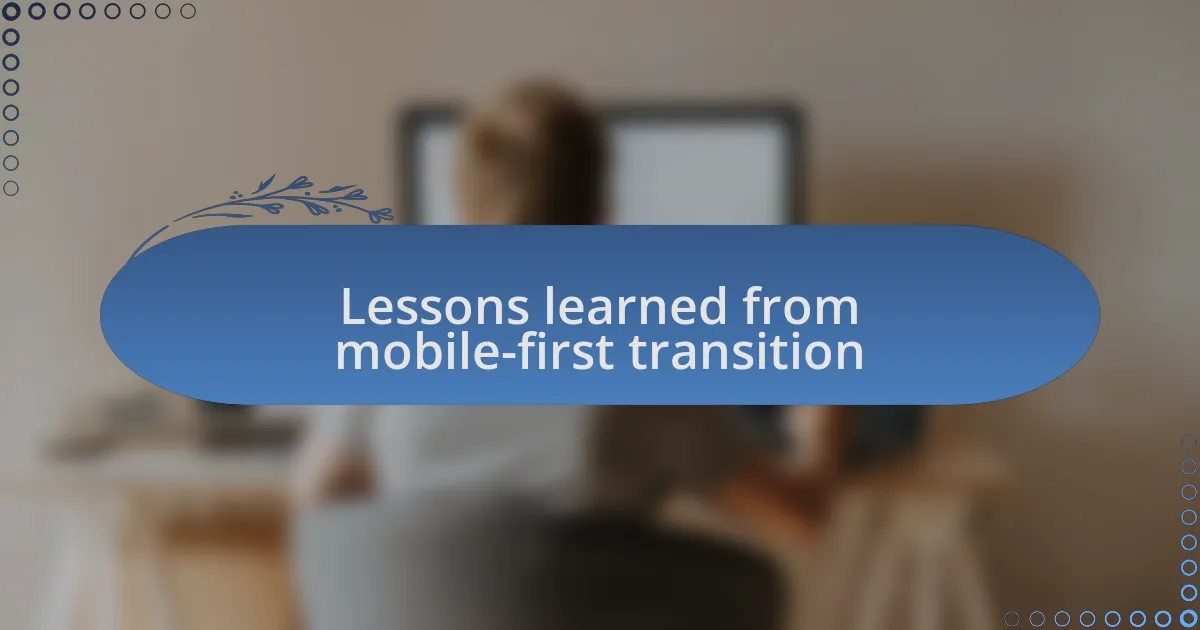
Lessons learned from mobile-first transition
Adopting a mobile-first approach taught me the importance of user empathy. I vividly recall a moment while reviewing analytics that showed a significant drop in engagement on smaller screens. It sparked a realization: I needed to see our website through the eyes of the mobile user. This shift in perspective not only guided our design choices but made it clear that understanding user behavior is key to creating an effective mobile experience.
One lesson that stood out was the necessity of prioritizing content. In our rush to adapt, my team often found ourselves clinging to features we loved but that ultimately cluttered the mobile interface. I had to reflect on a valuable lesson: less is more. By honing our focus on essential content, we not only improved loading times but also enriched the user experience, making it more intuitive and enjoyable.
I also learned the significance of continuous feedback throughout the transition. I initiated informal sessions with users to gather their thoughts on our changes, and I was struck by how candidly they shared their frustrations and preferences. This feedback loop not only highlighted areas for improvement but ignited my passion for creating solutions that truly resonate with our audience. It made me question: how often do we listen to our users during such transitions, and how can their insights shape our future endeavors? Engaging with users transformed our process into a collaborative effort, ultimately leading to more successful outcomes.